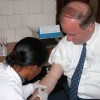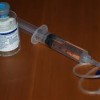Addressing the public’s concerns about human immunodeficiency virus transmission in health-care settings
Abstract
BACKGROUND: The 1990 report of a cluster of patients infected with the human immunodeficiency virus (HIV) associated with a Florida dentist with acquired immunodeficiency syndrome attracted considerable media coverage and legislative attention. A number of polls found that the public favored mandatory HIV-antibody testing of health-care workers.… Read more







